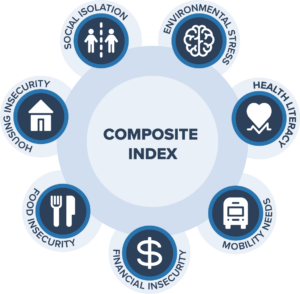
How Life Sciences Organizations Are Improving Medication Adherence Through Community Collaboration
U.S. healthcare faces a daunting challenge—one that life sciences organizations are uniquely positioned to help solve.
Drivers of Health
Healthcare organizations (especially payers and providers) are increasingly accountable for the health status of populations and communities. But only 10 to 20% of variability in health outcomes are directly influenced by medical care. In other words, doctor visits, trips to the emergency department, prescriptions, surgical procedures, treatment plans, blood tests, MRIs, and so on have limited impact on overall health. In fact, a person’s health outcomes are largely influenced by a range of drivers of health (DOH) that health systems, physician clinics, and health plans traditionally have no influence over. These drivers include housing security, food security, transportation, environmental conditions, region, and race and ethnicity, among other factors.
Medication Adherence
What does that have to do with life sciences? While life sciences organizations are not directly “accountable” for a population’s health outcomes or the health equity of a given community, DOH can and do affect the efficacy of their drugs and their overall profitability. For example, medication non-adherence has a significant impact on health outcomes while also costing the life sciences sector a lot of money—an estimated $637 billion in lost revenues annually for patients with chronic conditions alone. However, the role that DOH play in non-adherence is still under-appreciated.
The life sciences sector widely recognizes the role that drug costs play in improving medication adherence. The term “financial toxicity” has even emerged to describe the harsh emotional and economic stressors that some patients feel when their medical care, especially their medications, become too costly to afford. To improve medication adherence, many life sciences organizations offer support or access programs that make medications available at a discount or at no cost to patients with a specific level of demonstrated need. But such programs usually have limited uptake and fail to support all the patients who need help, or to take into account the complex set of challenges around DOH that too many patients face. According to a 2021 survey, life sciences companies spend more than $5 billion on patient support programs yearly, but only 3% of patients actually use them. In other words, drug costs are only the tip of the iceberg.
Overcoming Social Barriers to Health Through Collaboration
What can a life sciences organization do to overcome social barriers to health more broadly and effectively? Systemic challenges require systemic solutions. Hospitals, clinics, and health plans can’t address DOH comprehensively without working together and with different social services and community-based organizations. Life sciences organizations can and should play an important role in those efforts. In fact, without them, a big piece of the puzzle is missing.
By identifying DOH that influence medication-related challenges and developing a more coordinated strategy, life sciences organizations can enhance their current programs, improve medication adherence, advance their organizational mission, improve the health outcomes of patients, recapture billions in lost revenue, and elevate their level of engagement and collaboration with specific communities and partner organizations, patient populations, and prescribing physicians. Improvements like these can have cascading effects on drug development, clinical trials, market growth, and so on.
Let’s look at a three-step pathway for life sciences organizations to scale and enhance patient assistance and support programs while better addressing health equity and whole-person care through localized community support.

1. Leverage localized data to clarify the role that drivers of health play in health outcomes.
Health inequities pervade our society and have deep historical roots. They are caused and compounded by regional differences, economic factors, racism, demographics, and other factors. Fortunately, U.S. healthcare has the opportunity to impact these disparities and improve health for millions of people who otherwise struggle with diminished quality and length of life.
DOH affect health status and outcomes in many different ways. One patient might be more likely to contract cancer or a respiratory illness because of the environmental conditions of their community. Another might have difficulty getting to doctor’s appointments because public transportation is unreliable, or they live in a rural area far from clinics and hospitals. Another might find it difficult to manage their diabetes because they don’t have ready access to nutritious food.
Such inequities have a big impact on health, quality of life, and life expectancy. People who’ve been unemployed for more than six years, for example, have double the mortality rate of those with more steady jobs. People who are socially isolated are twice as likely to develop coronary artery disease. There’s a 16-year difference in life expectancy for residents of two Chicago neighborhoods separated by only six miles geographically—but they are worlds apart in terms of their access to resources and support.
The Healthcare System
DOH also increase pressure on the healthcare system. According to a 2020 report in Medical Care, people who require language services may be more likely to use the emergency department, increasing costs and taxing clinical resources. People enrolled in Medicare with low health literacy are more likely to experience hospital admission, higher medical costs, and lower access to care. Furthermore, people who experience housing instability are currently or potentially high-cost healthcare users.
To address these challenges and reduce their impact, many healthcare organizations are now implementing programs and processes to identify and help people who are at risk of poor health outcomes and in need of extra support.
Drug Effectiveness
Drug effectiveness is also influenced by DOH. Logically, drugs are only effective if patients take them as prescribed. But there can be many reasons why a patient doesn’t follow a doctor’s or pharmacist’s instructions. If a patient can’t afford their medications or co-pays, they might not pick up those prescriptions or they might take smaller or fewer doses than prescribed to make the medicine last longer. If they don’t have a stable home or a refrigerator, they might not be able to store their medicine safely and have it readily available. Or they might be forced to make trade-offs between paying for medications and paying the rent or buying groceries.
Social factors have a measurable impact across the patient journey. For example, minority participation rates in clinical trials are about 2–16% despite making up almost 39% of the U.S. population. This lack of trial diversity has the potential to cost the system over hundreds of billions of dollars through poor health and early deaths. People who are challenged by DOH are also 12% less likely to get preventative screenings or to adhere to their medications, according to Unite Us primary research on our own claims and our Social Needs System (SNS) data. Black patients with breast cancer have a 41% higher mortality rate than White patients. The list goes on. To improve medication adherence, life sciences organizations must take DOH factors into account.
Harnessing Data to Improve Health Outcomes
Reliable and scalable data sources help life sciences organizations identify social barriers to health, develop effective strategies for addressing them, and measure the impact of those interventions. To define a population, data sources should include the right clinical and social data, and be stratified by health disparity measures like race, income, and gender.
For example, a close look at marginalized communities within breast cancer populations reveals how DOH impact their health outcomes. That points the way to strategies that address negative DOH as early as possible to improve health outcomes. A comprehensive assessment starts with a look at the overall population of women over 18 in the U.S. to match them with data sets related to DOH. We can then identify women with an elevated DOH risk and develop more effective screening and treatment strategies to meet their needs. This understanding will also inform care navigation, care plans, adherence strategies, and so on.
That’s just one condition. The breast cancer journey will be different from the lung cancer journey or the diabetes journey. Data illuminates those differences and helps lay out appropriate solutions. That’s a good start for a more effective program, but to have a significant impact on health outcomes, life sciences organizations must engage with community-based organizations that can actually deliver the support patients need.
The Unite Us Social Needs System (SNS) is the Industry Standard for Assessing Drivers of Health
 Our SNS is a predictive framework that leverages comprehensive and integrated health and social care data to systematically identify and measure social, environmental, and economic risk. An accurate SNS score is based on 12 SNS Factors, including food insecurity, transportation needs, health literacy, financial literacy, uninsured, unemployed, childcare needs, housing quality, utility needs, lack of broadband internet, loneliness, and housing instability. The Unite Us Social Needs System (SNS) surfaces key areas of opportunity and actionable insights for social interventions to improve health and quality of life.
Our SNS is a predictive framework that leverages comprehensive and integrated health and social care data to systematically identify and measure social, environmental, and economic risk. An accurate SNS score is based on 12 SNS Factors, including food insecurity, transportation needs, health literacy, financial literacy, uninsured, unemployed, childcare needs, housing quality, utility needs, lack of broadband internet, loneliness, and housing instability. The Unite Us Social Needs System (SNS) surfaces key areas of opportunity and actionable insights for social interventions to improve health and quality of life.
2. Leverage the expertise and services of organizations in the community to connect patients with support they need.
Identifying at-risk people, screening them proactively, and prescribing the right medications all sounds good in theory, but how can life sciences organizations engage with those patients and help them get the resources they need to support their health care? No life sciences organization is equipped to supply nutritious food, transportation, or secure housing on its own. Instead, it must work closely with community-based organizations to provide those services.
Creating an Ecosystem of Care
Investing in health equity takes an ecosystem that includes life sciences, health systems, health plans, and community-based organizations with the patient at the center. Life sciences organizations must find ways to strategically partner with CBOs to make sure patients are getting the whole ecosystem of care that they need.
Just as the social care needs of individuals vary between local areas, so does the availability of organizations that supply the resources to meet those needs. We believe social care services should be available to people on a no-wrong-door basis. In other words, if a person in need of housing or nutritious food enters the ecosystem through a physician clinic, that clinic should be able to direct the person to a CBO that can help meet that need. Likewise, if a person who requires medication or clinical care enters the ecosystem through a food bank or a housing shelter, those organizations should be able to connect that person to an organization offering the medication or care they also need.
Patient Support Programs
Patient support programs can be enhanced through connected ecosystems like Unite Us to seamlessly direct individuals to community resources and connect community organizations with healthcare organizations. This enables all stakeholders to stay connected around the individual in need, and it facilitates data sharing that ensures those organizations follow through on every referral. Just as importantly, it reduces the burden on caregivers and social services providers by streamlining processes.
Life sciences organizations often partner with national groups to provide patient support but miss the mark on local connections. The COVID-19 pandemic brought this issue to the forefront. Since every region handled the pandemic differently, national groups were less effective in local communities. For example, during that period, the need for transportation soared in many regions around the country. Asked for support by our life sciences partners, Unite Us provided the infrastructure for connecting individuals in need with local providers of transportation wherever they lived. Those life sciences organizations were not the supplier of those resources, but they became the door through which patients accessed them. Other organizations in the community also benefited.
3. Measure the impact of community support to inform investment/partnership strategies.
The wonder of a connected data flow is that it provides continuous information on the changing needs of a population or community. It also informs stakeholders of the services that are actually being provided and reveals the impact on key measures like improving medication adherence, health status, and so on.
Unite Us is unique in being able to systematically measure how people are leveraging social services and whether their DOH are being appropriately and effectively addressed. This helps life sciences organizations learn even more about the people taking their medicines. For example, perhaps the initial assessment pointed to food insecurity as the biggest barrier to improving medication adherence, but the data gained through the program revealed that child care and secure housing were even more important drivers of medication adherence. These insights can inform future efforts, investments, and partnership strategies. They can also help the philanthropic arm of life sciences organizations engage more directly and effectively with patients, communities, and community organizations.
As that network of community-level partnership grows, life sciences organizations can deepen their ties in the community and begin to address health-related social needs even further upstream. They can then provide resources and support, for example, for community-based organizations to organize screening and preventative care interventions.
Health = Health Care + Social Care
Disparities in health equity and DOH affect health status, health outcomes, patient experience, quality of life, community health, and overall healthcare costs. Increasingly, U.S. healthcare is turning that understanding into action.
Data and Information-Sharing
Life sciences organizations have traditionally focused on access and support programs that help alleviate the cost of medications and related copays. But the underlying challenges affecting health are much deeper, more complex, and specific to individual populations and communities. A data-based understanding of social needs provides the groundwork for gaining insights that can inform more effective strategies and interventions. But those insights must be leveraged through partnerships with social services organizations on the ground to be effective. It takes a connected ecosystem of data and information sharing to activate the support that people need, and to keep improving those efforts and enhance impact.
Life sciences organizations have shown their willingness and desire to address significant social challenges through their philanthropic arms, and the impact of those efforts can be improved with data and community-level coordination. It’s time to innovate on traditional approaches with new strategies, technologies, and partnerships suitable for the size of the challenge before us.
With their for-profit and philanthropic resources and unique vantage point in the healthcare ecosystem, life sciences organizations can play a central role in communicating the full picture of an individual’s health and social care needs and coordinating efforts to address them. When they’re fully connected in a broader community network, life sciences organizations can be leaders in driving whole-person care.
Learn more about how Unite Us can help life sciences organizations transform patient services with whole-person care.


